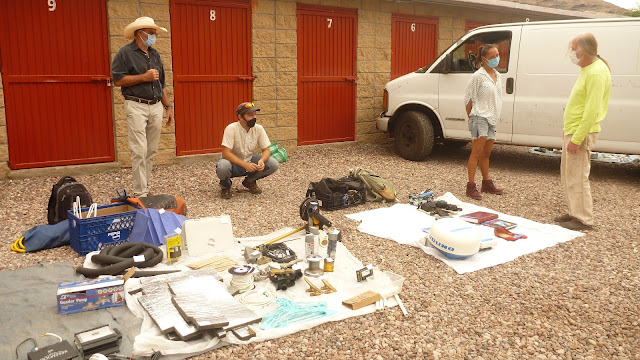From San Carlos we sailed in one day to Guaymas, straight into the Marina Fonatur. Being back in civilisation we had to get used of wearing a mask, whenever we left the boat. While there, the first swap-market since the begin of the pandemic took place and we were lucky to sell some items like our outboard motor (which was to heavy for the self-made dinghy), the 3rd propeller and the 4th anchor we had on board. Of course we found as well some items we where happy to buy
A week in Fonatur Marina seemed to pass very quickly as we organised ourselves and the boat for our haul out. We knew the three week window we were given would put us on a tight time schedule so a considerable amount of time was spent removing every thing we could from the deck to be ready for the paint crew to start work the moment the boat was secure on the stands. Much time was spent organising materials and parts from the United States, which we could not find in Mexico and which were brought over the border by car.
On the hard, the work took place in two stages the deck and cockpit first and then the cockpit locker lids which were removed, then strengthened and painted ashore. The crew set to work with there usual attention to detail in the preparation, creating huge clouds of grey dust which found its way into everything.
While we were at it we decided to increase the height of the coaming around the locker openings to provide better protection from water ingress which we discovered when cleaning the boat with a hose. Although we hadn’t had any problems while sailing, we hadn't experienced big seas in the Sea of Cortez and as such we felt that for open ocean cruising the coaming was too low.
While the paint crew were hard at work Renate and I set about some of the more minor differed projects and sanded and anti-fouled below the water line. Stainless steel plates were installed beneath the bow roller to protect the hull from anchor bite. We also moved the bow roller about 75mm further forward and this seems to have ameliorated the situation. I restored the companion way steps to their former glory and revarnished the tiller, while Renate painted the cabin sole and dealt with the last remaining green item on the boat, the bimini cover.
Last year we bought some Sunbrella type material in red to fabricate a new one. After giving this project some thought we considered that painting the offending article might be an easier and faster way to go. The canvas was Sunbrella in reasonable order, so after a few minor repairs Renate forged ahead with painting the bimini with red acrylic paint.

However, the paint dried to a nice shade of red.
The finished item looks very good in place on the boat and is now completely water proof. The only disadvantage is that the canvas is stiff and a little unwieldy, though this is only a minor inconvenience as it seldom removed or handled.
With the major painting work finished just in time for our three week deadline on the hard we were relaunched without our cockpit locker lids which were finished on the hard.
Slowly our orders from the United States arrived on the weekly run from Tucson. This included such items as a compressor for our Hookah system, Renate’s inflatable stand up paddle board (iSUP is the modern term), cam cleats, clutches, ropes, wind instrument transducer, more home brew beer kits for me and a new phone for Renate, just to mention a few. The list was long, there being so much equipment for sailing that is simply not available in Mexico. Once back in the water, the real work started for us. All removed ropes and hardware had to find their place back on the boat. Unfortunately some screw holes were filled when the painting preparation was done, these had to be redrilled before the deck fittings could be re-installed. Some of the fittings were re-organised to better accommodate the split sheeting arrangement of the fore sail.
The Cockpit lids took longer than expected. All box lids needed to be re-glued and strengthened with fibreglass, which took a further three weeks to complete. In the mean time we found plenty of other things to do while we waited. After the work mentioned above, Renate took the sewing machine out and sewed bags for her newly purchased iSUP and the hookah compressor and fittings. She also made a smart new cover for my painstakingly varnished tiller and new mast boots fore and aft. Almost every item she sews has a miniature Taiko icon sewed onto it, similar to those sewed onto the sails. I think it verges on the excessive, but that’s fine, it is demonstrated love and pride in her ship.
I installed two new 300W solar-panels, each with its own smart regulator. Regrettably, it seems this may have been a folly, the output does not seem to be any better than our old 480W combination with PWM regulator. Another folly was the installation of the Balmar high output alternator, left on board by the previous owner Richard, and the new engine pulley conversion kit. This had to be removed and the old system re-installed when it stopped charging. I remain perplexed as to why. Restoring its functionality will be a job for later.
We could at last re-fit the cockpit locker lids. A few days later we were ready to leave Guaymas to cross the Sea of Cortez to Santa Rosalia on the peninsular of the Baja California.












No comments:
Post a Comment